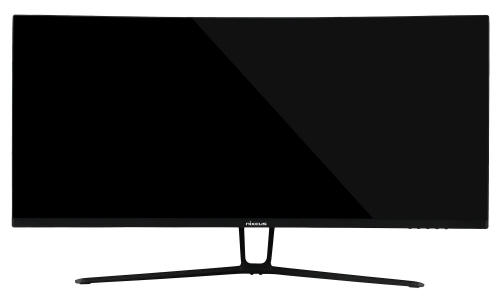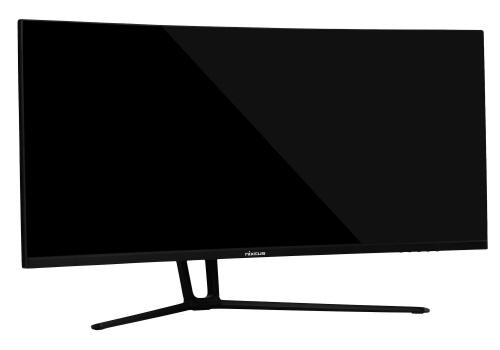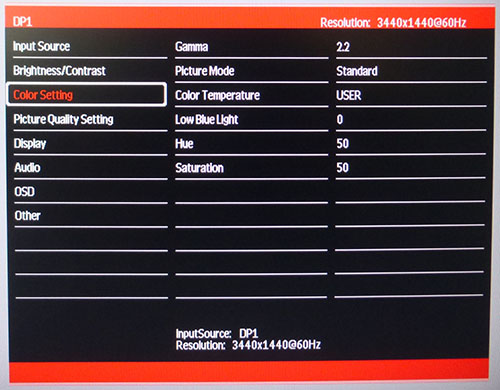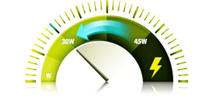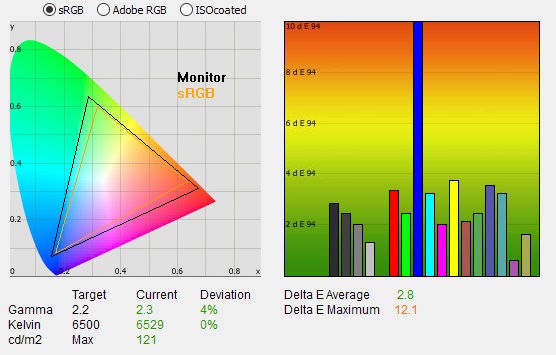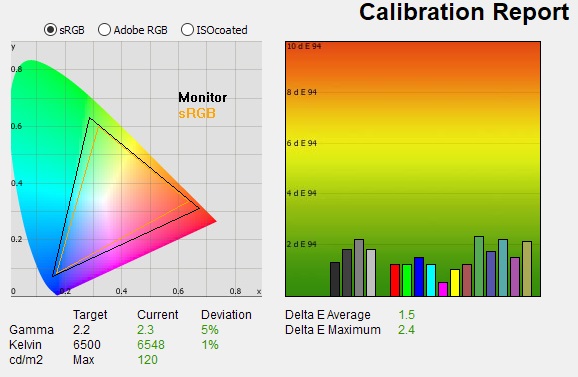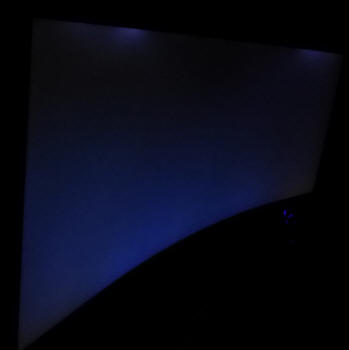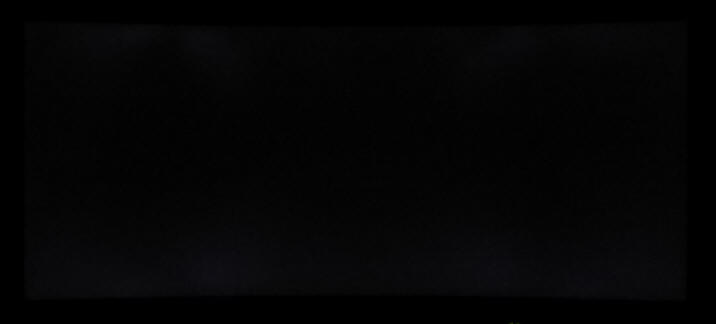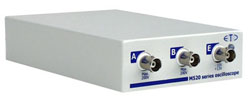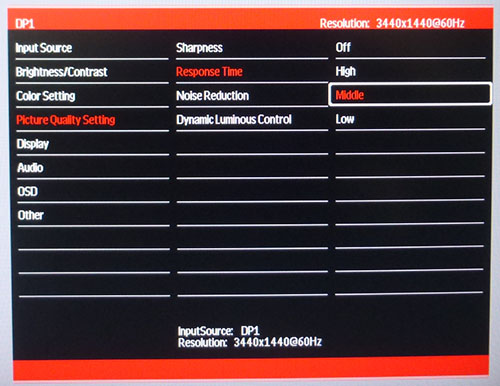|
|
||||
|
||||
|
|
|
|||||||||||||||||||||||||||||||||||||||||||||||||||||||||||||||||||||||||||||||||||||||||||||||||||||||||||||||||||||||||||||||||||||||||||||||||||||||||||||||||||||||||||||||||||||||||||||||||||||||||||||||||||||||||||||||||||||||||||||||||||||||||||||||||||||||||||||||||||||||||||||||||||||||||||||||||||||||||||||||||||||||||||||||||||||||||||||||||||||||||||||||||||||||||||||||||||||||||||||||||||||||||||||||||||||||||||||||||||||||||||||||||||||||||||||||||||||||||||||||||||||||||||||
|
Monitor Specifications |
|||
|
Size |
34" ultrawide |
Panel Coating |
Light AG coating |
|
Aspect Ratio |
21:9 curved 1500R |
Interfaces |
2x DisplayPort 1.4
2x HDMI 2.0 |
|
Resolution |
3440 x 1440 |
||
|
Pixel Pitch |
0.2325mm |
Design colour |
Matte black bezels and enclosure. Black metal stand and foot |
|
Response Time |
4ms G2G |
Ergonomics |
EDG34S model = tilt only |
|
Static Contrast Ratio |
3000:1 |
||
|
Dynamic Contrast Ratio |
not listed |
VESA Compatible |
Yes 75 x 75 mm with included plate |
|
Brightness |
350 cd/m2 (typical) |
Accessories |
DisplayPort and power cables (no HDMI cable provided) |
|
Viewing Angles |
178 / 178 |
||
|
Panel Technology |
Samsung SVA (VA-type) |
Weight |
not listed |
|
Backlight Technology |
W-LED |
Physical Dimensions (WxHxD) |
not listed |
|
Colour Depth |
1.07 billion (8-bit+FRC) |
||
|
Refresh Rate |
144Hz |
Special Features |
AMD FreeSync Premium certified, red lights on the rear of the screen |
|
Colour Gamut |
Wide gamut 100% sRGB listed, 88% DCI-P3 measured |
||
The EDG34 offers a reasonable range of modern connectivity with 2x DisplayPort 1.4 and 2 x HDMI 2.0 offered for video connections. These are located on the back of the screen along with a headphone output. For PC connectivity the DisplayPort is the most common option, with HDMI being available then for connecting external games consoles or Blu-ray players potentially. The screen has an internal power supply and comes packaged with the power cable that you need. Unusually for a modern screen there are no added USB ports on this model.
Below is a summary of the features and connections of the screen.
|
Feature |
Yes / No |
Feature |
Yes / No |
|
Tilt adjust |
|
DVI |
|
|
Height adjust |
|
HDMI |
|
|
Swivel adjust |
|
USB type-C |
|
|
Rotate adjust |
|
DisplayPort |
|
|
VESA compliant |
|
Component |
|
|
USB 2.0 Ports |
|
Audio connection |
|
|
USB 3.0 Ports |
|
HDCP Support |
|
|
Card Reader |
|
Integrated Speakers |
|
|
Ambient Light Sensor |
|
PiP / PbP |
|
|
Human Motion Sensor |
|
Blur Reduction Mode |
|
|
Touch Screen |
|
NVIDIA G-Sync (native) |
|
|
Factory calibration |
|
AMD FreeSync |
|
|
Hardware calibration |
|
G-sync Compatible Certified |
|
|
Uniformity correction |
|
Meaningful HDR |
|

Design and
Ergonomics
The EDG34 comes in a mostly black design with matte plastics used for the bezels and rear enclosure. There is a 3-side "borderless" panel used with a thin 2mm plastic edge around the sides and top, with an additional 8mm black panel border before the image starts. The bottom has a traditional thicker plastic bezel measuring 16mm. There is also a 2mm black panel border along this bottom edge. The stand is a black aluminium design and needs to be screwed together when unpacking it from the box.
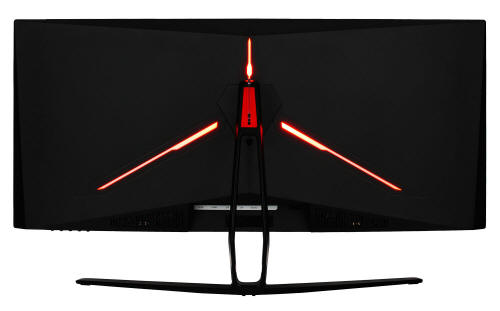
Above: rear view of the screen.
Click
for larger version
The back of the screen is encased in a matte black plastic for a simple design. There is a red trim section at the top of the stand, and a fold-down plastic headphone hook located there if you need it. There are 3 red coloured lights on the back of the screen as shown in the picture above, which can be turned of in OSD if you want. They can also be set to a "flicker" setting but not really sure why you'd ever want that unless you were trying to put other gamers off at an event perhaps!
The OSD controls are located on the bottom right hand edge of the screen. There are 3 quick access buttons to the brightness, volume and input controls. The OSD is split in to 8 sections down the left hand side, with the available options shown in the middle column. There's quite a lot of settings to play around with and navigation was easy enough, a little fiddly sometimes remembering which button selected an option and which one went back a stage, but easy enough after a bit of use.
We have the EDG34S model with us for review which only has a very basic tilt adjustment stand. The EDG34 model has a more versatile stand with tilt, height and swivel adjustments. The rest of the performance/spec/features remains identical between the two models.
The stand on the S model was very limited really. The tilt adjustment is smooth and easy enough to move, but doesn't provide much adjustment tilting backwards. The screen also sits pretty low down on the stand and is lower than we would normally like for a comfortable viewing position. The bottom edge of the screen sits about 95mm from the top of the desk. We would recommend looking at the EDG34 (with full stand) or considering a VESA mount if you're buying the S model. The screen does at least stay pretty stable when being moved or knocked with low levels of wobble.
A summary of the ergonomic adjustments are shown below:
|
Function |
Range |
Smoothness |
Ease of Use |
|
Tilt |
Yes |
Smooth |
Easy |
|
Height |
No |
- |
- |
|
Swivel |
No |
- |
- |
|
Rotate |
No |
- |
- |
|
Overall |
Very limited adjustments from the S model and the screen is too low really. |
||
The materials were of a good standard and the build quality felt decent enough. There was no audible noise from the screen, even when conducting specific tests which can often identify buzzing issues. The whole screen remained cool even during prolonged use.

The back of the screen features the connections as shown above, with 2x HDMI 2.0, 2x DisplayPort 1.4 and an audio headphone output. With the stand being fairly limited, they are not the easiest to get to when you first plug everything in.

Power Consumption
|
|
|
We have plotted these results below compared with other screens we have tested. The consumption (comparing the calibrated states) is actually quite a bit lower than the other 34"+ sized screens we've tested and was more comparable to smaller 27" models. The larger screens tend to have additional power usage but the Nixeus seemed to be an exception to this rule.
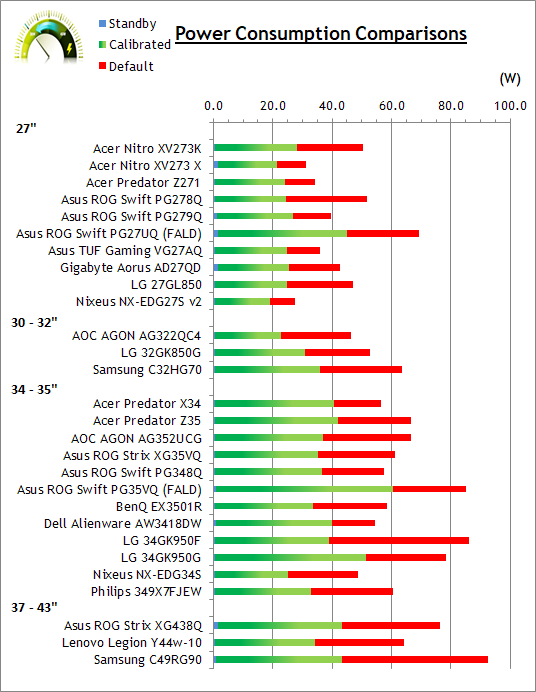

Panel and Backlighting
|
Panel |
Backlight |
||
|
Panel Manufacturer |
Samsung |
Backlighting Type |
W-LED |
|
Panel Technology |
SVA (VA-type) |
Colour space |
Wide gamut |
|
Panel Part |
LSM340YP05 |
sRGB coverage spec |
100% |
|
Screen Coating |
Light anti-glare |
DCI-P3 spec |
not listed (88% measured) |
|
Colour Palette |
1.07 billion |
Adobe RGB coverage spec |
not listed |
|
Colour depth |
10-bit (8-bit + FRC) |
Flicker free verified |
|
Note that the Nixeus website lists a 16.7m colour depth (8-bit) and only mentions 100% sRGB gamut. Above spec is confirmed from our testing with 10-bit support, and a wider colour gamut is confirmed in the following sections
Backlight dimming at calibrated brightness setting
(no PWM)
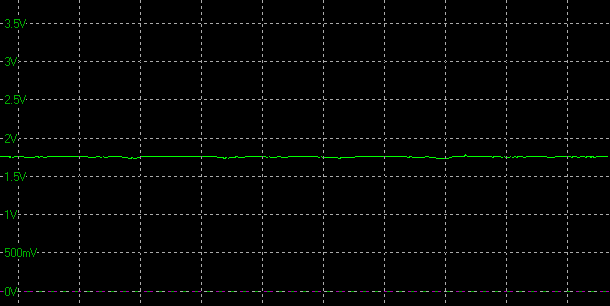
Above:
backlight operation showing constant Direct Current voltage instead of PWM.
Measured at calibrated brightness level

Brightness
and Contrast
This section tests the full range of luminance (the brightness of the screen) possible from the backlight, while changing the monitors brightness setting in the OSD menu. This allows us to measure the maximum and minimum adjustment ranges, as well as identify the recommended setting to reach a target of 120 cd/m2 for comfortable day to day use in normal lighting conditions. Some users have specific requirements for a very bright display, while others like a much darker display for night time viewing or in low ambient light conditions. At each brightness level we also measure the contrast ratio produced by the screen when comparing a small white sample vs. a black sample (not unrealistic full screen white vs. full screen black tests). The contrast ratio should remain stable across the adjustment range so we also check that.
Graphics card settings were left at default with no ICC profile or calibration active. Tests were made using an X-rite i1 Display Pro Plus colorimeter. It should be noted that we used the BasICColor calibration software here to record these measurements, and so luminance at default settings may vary a little from the LaCie Blue Eye Pro report you will see in other sections of the review.
|
OSD Brightness |
Luminance |
Black Point (cd/m2) |
Contrast Ratio |
|
100 |
402.43 |
0.12 |
3354 |
|
90 |
403.73 |
0.12 |
3364 |
|
80 |
379.38 |
0.11 |
3449 |
|
70 |
362.00 |
0.11 |
3291 |
|
60 |
335.89 |
0.10 |
3359 |
|
50 |
318.40 |
0.09 |
3538 |
|
40 |
291.02 |
0.09 |
3234 |
|
30 |
258.88 |
0.08 |
3236 |
|
20 |
219.93 |
0.07 |
3145 |
|
10 |
133.14 |
0.04 |
3328 |
|
0 |
62.40 |
0.02 |
3120 |
|
Total Luminance Adjustment Range (cd/m2) |
340.03 |
Brightness OSD setting controls backlight |
|
|
Total Black Point Adjustment Range (cd/m2) |
0.10 |
||
|
Average Static Contrast Ratio |
3311:1 |
PWM Free |
|
|
Recommended OSD setting for 120 cd/m2 |
7 - 8 |
At the full brightness setting in the OSD the maximum luminance reached a high 402 cd/m2 which was nicely in line with the 'max brightness' spec from the manufacturer. There was a good 340 cd/m2 adjustment range in total, so at the minimum setting you could reach down to a luminance of 62 cd/m2. This offers a reasonably low luminance for working in darkened room conditions with low ambient light. A setting of 7 - 8% in the OSD menu should return you a luminance of around 120 cd/m2 at default settings. It should be noted that the brightness regulation is controlled without the need for Pulse Width Modulation for all brightness settings so the screen is flicker free.
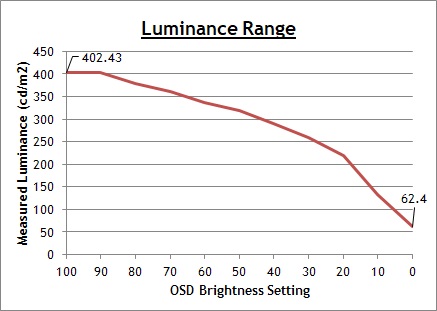
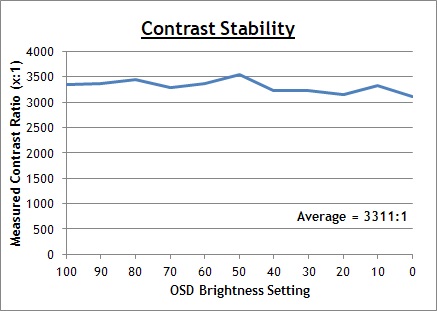
We have plotted the luminance trend on the graph above. The screen behaves as it should, with a reduction in the luminance output of the screen controlled by the reduction in the OSD brightness setting. This is not a linear relationship though with the brightness control not doing anything between 100 and 90%, and then being quite subtle between 90 and 20% controlling more minor changes to the luminance output of the backlight. From 20 down to 0 each step in the brightness control changes the luminance more significantly as you can see. At this lower end, you don't have quite the control over minute adjustments as you might like, but it's still adequate.
The average contrast ratio of the screen was measured at an impressive 3311:1 out of the box which was strong thanks to the VA technology panel. This was a little higher even than the specified 3000:1 typical contrast ratio and a definite strength of this panel technology.
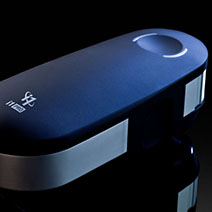
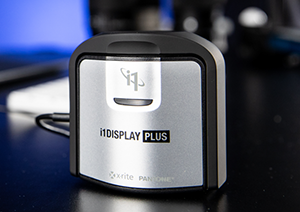
An important thing to consider for most users is how a screen will perform out of the box and with some basic manual adjustments. Since most users won't have access to hardware colorimeter tools, it is important to understand how the screen is going to perform in terms of colour accuracy for the average user.
We restored our graphics card to default settings and disabled any previously active ICC profiles and gamma corrections. The screen was tested at default factory settings using our new X-rite i1 Pro 2 Spectrophotometer combined with LaCie's Blue Eye Pro software suite. An X-rite i1 Display Pro Plus colorimeter was also used to verify the black point and contrast ratio since the i1 Pro 2 spectrophotometer is less reliable at the darker end.
Targets for these tests are as follows:
-
CIE Diagram - confirms the colour space covered by the monitors backlighting in a 2D view, with the black triangle representing the displays gamut, and other reference colour spaces shown for comparison. Usually shown as a comparison against the common sRGB space
-
Colour space coverage volumes - we also measure using a piece of software called ChromaPure the colour space (gamut) volumes produced by the backlight in comparison to the sRGB, DCI-P3 and Rec.2020 colour spaces. sRGB is the most commonly used colour space so it is important to have a decent coverage from the screen here. If the colour space is >100% sRGB then the screen can produce a wider colour gamut, often reaching further in to the wider gamut DCI-P3 (commonly used for HDR) and Rec.2020 reference spaces.
-
Gamma - we aim for 2.2 which is the default for computer monitors
-
Colour temperature / white point - we aim for 6500k which is the temperature of daylight
-
Luminance - we aim for 120 cd/m2, which is the recommended luminance for LCD monitors in normal lighting conditions
-
Black depth - we aim for as low as possible to maximise shadow detail and to offer us the best contrast ratio
-
Contrast ratio (static) - we aim for as high as possible. Any dynamic contrast ratio controls are turned off here if present
-
dE average / maximum - we aim for as low as possible. If DeltaE >3, the color displayed is significantly different from the theoretical one, meaning that the difference will be perceptible to the viewer. If DeltaE <2, LaCie considers the calibration a success; there remains a slight difference, but it is barely undetectable. If DeltaE < 1, the color fidelity is excellent.

Default Performance
and Setup
Default settings of the screen were as follows:
|
Nixeus
NX-EDG34S
|
|
|||||||||||||||||||||||||||||
|
|
The display was set with a pretty bright 65% brightness which was uncomfortable to use for long periods. You will want to turn that down as with most screens. The colour balance and whites felt a bit warm and you could tell that the screen was offering a wide colour gamut, with colours looking more vivid and saturated than typical sRGB screens. It wasn't as vivid as some other recent wide gamut screens we've tested quite, but it was more than typical sRGB screens. This was actually contrary to the listed spec on the Nixeus website which only mentions 100% sRGB and doesn't mention this wider gamut support. We went ahead and measured the default state with the i1 Pro 2. The CIE diagram on the left of the image confirms that the monitors colour gamut (black triangle) extends a fair way beyond the sRGB reference space (orange triangle), mostly in green and red shades. We measured using ChromaPure software a 119.2% sRGB gamut volume coverage which corresponds to 87.8% of the DCI-P3 reference and 63.0% of the Rec.2020 reference. Note that on this screen there is no sRGB emulation mode, so you will be limited to using the wider DCI-P3 gamut all the time. The screen is firmly aimed at gaming and multimedia, so this is unlikely to be an issue for those uses. |
|
Default gamma was recorded at 2.3 average with a small 6% deviance from the target which was reasonably close to the target. There are other gamma modes in the OSD but none are closer to the 2.2 target. For reference the gamma modes and our measurements of average gamma are: mode 1.8 = 1.4, mode 2.0 = 2.0, mode 2.2 = 2.3, mode 2.4 = 3.1 and mode 2.6 = 3.2. These may be useful in some gaming situations potentially.
White point was measured at 6051k, being a bit too warm compared to our target of 6500k (7% deviance). We did also measure the other modes and found that cool = 7729k and the user mode was 6011k. You can adjust the RGB levels though in this user mode which should allow easy correction of the white point anyway.
Luminance at the default 65% brightness level was recorded at a bright 365 cd/m2 which is too high for prolonged general use, you will need to turn that down. The black depth was 0.10 cd/m2 at this default brightness setting, giving us a very strong static contrast ratio thanks to the VA-type panel of 3503:1. Colour accuracy measurements should be ignored here as they are comparing the produced wider gamut display colours against an sRGB reference which will always lead to errors. When testing the screen with colour gradients there were mostly smooth transitions with a small amount of banding and some gradation in darker tones.
![]()
Optimal Settings
Pre-Calibration
We also measured the screen after adjusting
only the OSD controls, to
obtain the optimal setup without a full calibration, and without the use of an
ICC correction profile. This represents what could be achieved through just
simple changes to the monitor itself, and also what you could expect when
working with content outside of an ICC profile managed workflow. The early
stages of our calibration software helped identity these optimal OSD settings.
|
Nixeus
NX-EDG34S
|
|
|||||||||||||||||||||||||||||
|
We could correct the white point and brightness here, and the dE readings should be ignored in the above report as they are comparing the wide gamut colours against an sRGB reference. Ignoring that, these optimal settings have helped correct the white point to approximately 6500k and reduce the brightness to a more comfortable level. The contrast ratio as dropped a little to correct that white point, but still remains strong thanks to the VA panel. Further calibration and profiling below will help improve things even further.
We used the X-rite i1 Pro 2 Spectrophotometer combined with the LaCie Blue Eye Pro software package to achieve these results and reports. An X-rite i1 Display Pro Plus colorimeter was used to validate the black depth and contrast ratios due to lower end limitations of the i1 Pro device.
|
Nixeus
NX-EDG34S
|
|
|||||||||||||||||||||||||||||
|
The OSD settings were adjusted as shown in the table above, as guided during the calibration process and measurements. These OSD changes allowed us to obtain an optimal hardware starting point and setup before software level changes would be made at the graphics card level. We left the LaCie software to calibrate to "max" brightness which would just retain the luminance of whatever brightness we'd set the screen to, and would not in any way try and alter the luminance at the graphics card level, which can reduce contrast ratio. These adjustments before profiling the screen would help preserve tonal values and limit banding issues. After this we let the software carry out the LUT adjustments and create an ICC profile.
Despite several attempts, the gamma curve proved difficult to correct fully, and we were left with a small 5% deviance overall. Lighter grey shades seemed to be the problem for further correction. The white point was also now corrected though to 6545k which was good. The brightness control adjustment had reduced the luminance to a comfortable level now, and the screen maintained a strong static contrast ratio of 3005:1 thanks to the VA-type panel. Colour accuracy of the resulting profile was good although not excellent, with dE average of 1.5 and maximum of 2.4. Again it proved difficult to improve the dE any further. LaCie would consider colour fidelity to be decent overall with a slight difference left. Gradients remained pretty similar to default settings, being mostly smooth with a little bit of banding and gradation in the darker shades.
You can use our settings and try our calibrated ICC profile if you wish, which are available in our ICC profile database. Keep in mind that results will vary from one screen to another and from one computer / graphics card to another.

Setup Comparisons
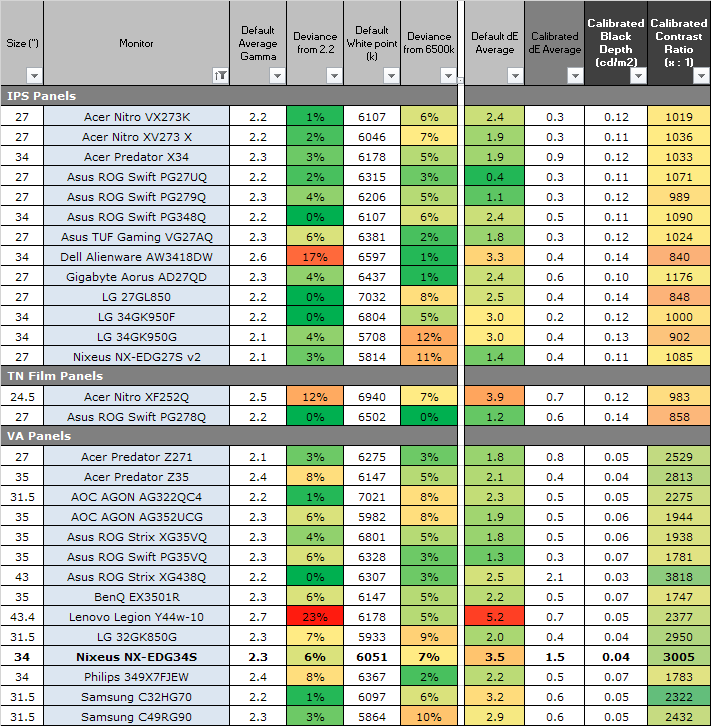
The comparisons made in this section try to give you a better view of how each screen performs, particularly out of the box which is what is going to matter to most consumers. We have divided the table up by panel technology as well to make it easier to compare similar models. When comparing the default factory settings for each monitor it is important to take into account several measurement areas - gamma, white point and colour accuracy. There's no point having a low dE colour accuracy figure if the gamma curve is way off for instance. A good factory calibration requires all 3 to be well set up. We have deliberately not included luminance in this comparison since this is normally far too high by default on every screen. However, that is very easily controlled through the brightness setting (on most screens) and should not impact the other areas being measured anyway. It is easy enough to obtain a suitable luminance for your working conditions and individual preferences, but a reliable factory setup in gamma, white point and colour accuracy is important and some (gamma especially) are not as easy to change accurately without a calibration tool.
From these comparisons we can also compare the calibrated colour accuracy, black depth and contrast ratio. After a calibration the gamma, white point and luminance should all be at their desired targets.
Default setup of the screen out of the box
was pretty decent overall. There was a pretty decent gamma which was great news as
this is often the hardest thing to correct without a calibration device. There
was a strong default contrast ratio thanks to the VA panel too as you might
expect. White point was a little too warm, but easy to correct through some
simple RGB control changes. There was unfortunately no sRGB emulation mode
available which might be a gap for some people who want to work with the more
common colour space for photo/colour critical work. However, for those wanting
to use the screen for gaming and multimedia (the target market), the wider gamut
will be welcome we expect compared to if it had been a standard sRGB gamut
model. Overall a decent performance
though considering it's a
gaming screen and these are often set up with much less accurate options.
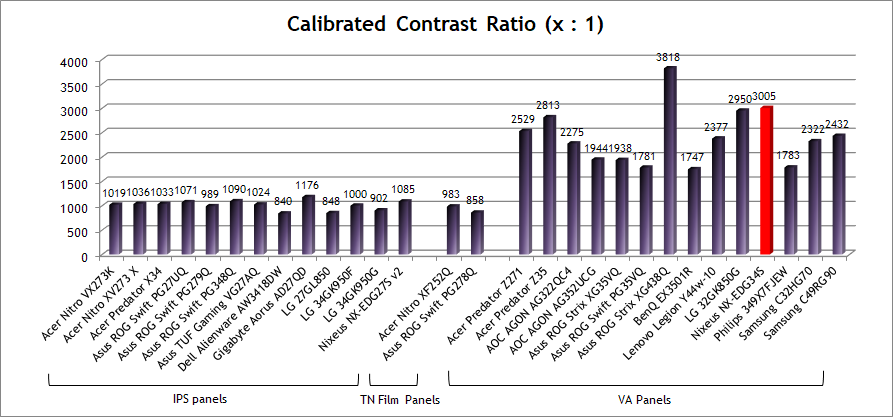
The contrast ratio was strong thanks to the VA technology panel and was measured at 3005:1 after calibration. This was higher than competing IPS and TN Film technology panels which typically deliver around 850 - 1100:1.
|
Check Pricing and Buy - Affiliate Links |
|
TFTCentral is a participant in the Amazon Services LLC Associates Programme, an affiliate advertising programme designed to provide a means for sites to earn advertising fees by advertising and linking to Amazon.com, Amazon.co.uk, Amazon.de, Amazon.ca and other Amazon stores worldwide. We also participate in a similar scheme for Overclockers.co.uk. |

Viewing Angles
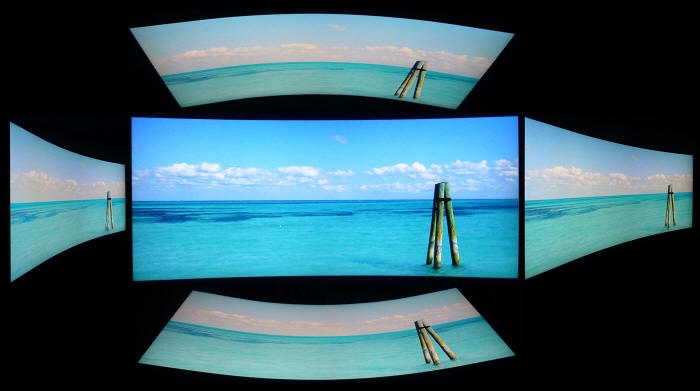
Above: Viewing angles shown from front and side, and from above and below.
Click for larger version
Viewing angles of the screen were good overall, and a little better than some other modern VA panels we've tested. From a moderately wide side angle the image would become washed out and pale in appearance as you can see, getting more pronounced the wider that angle was. Vertically the washout was a little more noticeable but not terrible.
The EDG34S has a Samsung VA panel and this had a bit better viewing angles than recent models featuring AU Optronics AMVA panels like the Asus ROG Swift PG35VQ and Asus ROG Strix XG438Q for instance, with a little less colour and gamma shift. The EDG34S was quite comparable to the Samsung C49RG90 and Lenovo Legion Y44w-10 we tested recently, which also feature Samsung VA panels. It appears that the viewing angles of Samsung VA panels are a little better than competing AU Optronics VA equivalents in general.
These strong viewing angles were very beneficial on a screen as large and as wide as this, helping to minimise unwanted colour and gamma shift as you look towards the edges of the screen, which are quite a long way away from your central viewing position. The screen is very, very wide so there is still some change but it's not too bad. The curve of the screen was also useful in this area, again given the very wide field of vision. The colour tone and gamma shifts were still a bit more noticeable than IPS-type panels though.
Users should also be aware that the panel exhibits the off-centre contrast shift which is inherent to the VA pixel structure. When viewing a very dark grey font for example on a black background, the font almost disappears when viewed head on, but gets lighter as you move slightly to the side. This is an extreme case of course as this is a very dark grey tone we are testing with. Lighter greys and other colours will appear a little darker from head on than they will from a side angle, but you may well find you lose some detail as a result. This can be particularly problematic in dark images and where grey tone is important. It is this issue that has led to many graphics professionals and colour enthusiasts choosing IPS panels instead, and the manufacturers have been quick to incorporate this alternative panel technology in their screens. We would like to make a point that for many people this won't be an issue at all, and many may not even notice it. Remember, many people are perfectly happy with their TN Film panels and other VA based screens. Just something to be wary of if you are affected by this issue or are doing colour critical work.
Above: View
of an all black screen from the sides. Click for larger version
On a black image from a side view there is very little glow from the panel, and the deep blacks and strong contrast ratio are still evident. You don't get the same pale/white glow that IPS-type panels exhibit (example recently tested Asus TUF Gaming VG27AQ with IPS-type panel) which is a big plus for this panel technology, especially if you want to use the screen for night time gaming or movies in a darker room. There are some uniformity problems on this sample when viewed in this way, which is something we'd seen on other recent VA panels too including the very expensive ROG Swift PG35VQ. You can see some areas of backlight glow and blotchiness on this kind of test particularly at the top. Again these results were pretty similar to the recently tested Samsung C49RG90 and Lenovo Legion Y44w-10.
We wanted to test here how uniform the brightness was across the screen, as well as identify any leakage from the backlight in dark lighting conditions. Measurements of the luminance were taken at 36 points across the panel on a pure white background. The measurements for luminance were taken using BasICColor's calibration software package, combined with an X-rite i1 Display Pro colorimeter with a central point on the screen calibrated to 120 cd/m2. The below uniformity diagram shows the difference, as a percentage, between the measurement recorded at each point on the screen, as compared with the central reference point.
It is worth noting that panel uniformity can vary from one screen to another, and can depend on manufacturing lines, screen transport and other local factors. This is only a guide of the uniformity of the sample screen we have for review.
![]()
Uniformity of Luminance
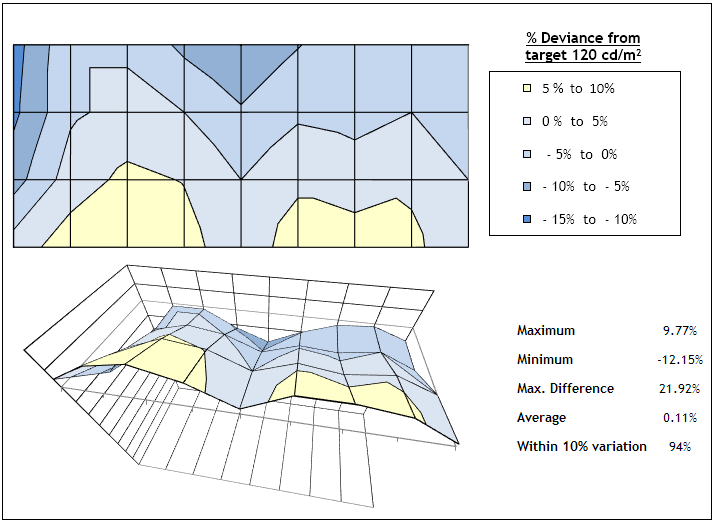
Luminance uniformity of the screen was good on our sample, with 94% of the screen within a 10% deviance of the centrally calibrated area. Along the left hand edge and upper middle region the screen was a little darker and there was a modest drop in luminance down to 107 cd/m2 in the most extreme case (-15%), but nothing too severe. The bottom part of the screen was also a little brighter up to 133 cd/m2 max.
![]()
Backlight Leakage
Above: All
black screen in a darkened room. Click for larger version
We also tested the screen with an all black image and in a darkened room. A camera was used to capture the result. There were a couple of areas where the backlight shone through a bit more brightly along the top and bottom edge of the screen, but they were very hard to see in normal usage, and hard to capture in the photograph above as the black depth of the panel was very good. They became a little more noticeable from a wider viewing angle when viewing darker content.
Note: if you want to test your own screen for backlight bleed and uniformity problems at any point you need to ensure you have suitable testing conditions. Set the monitor to a sensible day to day brightness level, preferably as close to 120 cd/m2 as you can get it (our tests are once the screen is calibrated to this luminance). Don't just take a photo at the default brightness which is almost always far too high and not a realistic usage condition. You need to take the photo from about 1.5 - 2m back to avoid capturing viewing angle characteristics, especially on IPS-type panels where off-angle glow can come in to play easily. Photos should be taken in a darkened room at a shutter speed which captures what you see reliably and doesn't over-expose the image. A shutter speed of 1/8 second will probably be suitable for this.

General and Office Applications
One of the key selling points of ultra-wide screens like the this is it's high resolution and large screen size. The 3440 x 1440 display offers a sharp but comfortable picture. Its pixel area is about 1.8 times larger than an Ultra-Wide Full HD 21:9 monitor, and about 2.4 times larger than a Full HD 16:9 monitor. It provides an efficient environment in using Microsoft Office programs showing 47 columns and 63 rows in excel. Thankfully the high resolution is of a very comfortable size on the 34" panel, with a 0.2325mm pixel pitch is is very comparable to a 27" 2560 x 1440 monitor (0.2331mm). This means you are basically getting a wider desktop to work with, with a similar font size to a 27" model, and maintaining the same vertical resolution as well. If you're coming from a lower resolution / larger pixel pitch you may still find the fonts look quite small to start with, but like the 27" 1440p models out there you soon get used to it. Side by side multi-tasking on this screen is excellent and you really do have a nice wide area to work with. We liked the curved format of the display actually for day to day office work. It just felt a bit more comfortable than a flat screen on a model as wide as this, bringing the corners a bit nearer to you. You didn't really notice the curve in normal use but we liked the feel. Probably down to user taste, so if in doubt try and see one in person.
The out of the box setup was pretty good for these kind of uses too, with a fairly reliable gamma and decent contrast ratio. The white point needs some minor correction but that's easy to do. There's unfortunately no sRGB emulation mode option which might make it tricky if you want to specifically work in that colour space and aren't working in a colour managed workflow. The brightness range of the screen was good, with the ability to offer a luminance between 402 and 62 cd/m2. This gives you flexibility even in darker room conditions and low ambient light conditions. A setting of 7 - 8 in the OSD brightness control should return you a luminance close to 120 cd/m2 out of the box. We would have liked a better control over the lower brightness range though as the adjustment curve was very steep here. The brightness regulation is controlled via a flicker free backlight, without the need for Pulse Width Modulation (PWM), and so those who suffer from eye fatigue or headaches associated with flickering backlights need not worry. There was no audible noise from the screen, even when conducting specific tests which can sometimes cause issues.
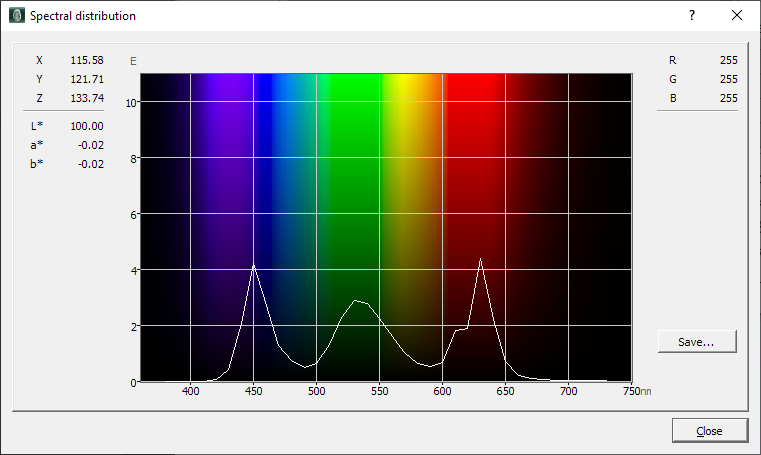
Spectral distribution graph
showing calibrated mode at 6500k
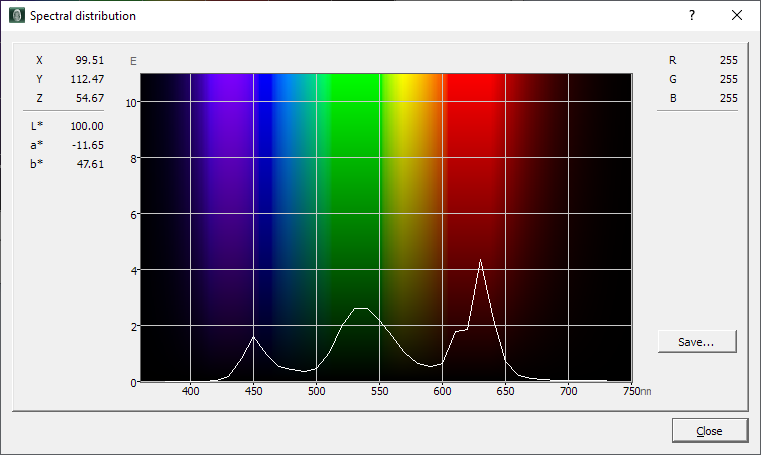
Spectral distribution graph
with Low Blue Light set to 100
(max)
There are several options for blue light reduction on this screen with settings of 0 (off), 25, 50, 75 and 100. As you increase this setting the colour temperature is basically just made warmer each time. At the maximum 100 setting the white point was measured at a much warmer 4450k, but did reduce the blue spectral output as shown above. These quick access options may be useful to some people for office or text work.
There are no USB ports provided on this screen which is quite rare nowadays. There are also no other extras like ambient light sensors, motion sensors or card readers on this screen which are sometimes useful for office-type uses. There is a very limited range of ergonomic adjustments from the stand for the EDG34S model with only a pretty limited tilt offered. The height of the screen is a bit too low for our liking too, so we would definitely recommend looking at the EDG34 with the more versatile stand. There is also VESA 75mm mounting capabilities for those who want to mount the screen instead though.

Responsiveness and Gaming
|
Panel Manufacturer and Technology |
Samsung SVA (VA-type) |
|
Panel Part |
LSM340YP05 |
|
Quoted G2G Response Time |
4ms G2G |
|
Quoted MPRT Response Time |
n/a |
|
Overdrive Used |
|
|
Overdrive Control Available Via OSD Setting |
Response Time |
|
Overdrive OSD Settings |
Off, Low, Middle, High |
|
Maximum Refresh Rate |
144Hz DisplayPort |
|
Variable Refresh Rate technology |
AMD FreeSync |
|
Variable Refresh Rate Range |
48 - 144Hz with LFC (DisplayPort only) |
|
Motion Blur Reduction Backlight |
|
The screen uses overdrive technology to boost pixel transitions across grey to grey changes as with nearly all modern displays. The part being used is a Samsung LSM340YP05 SVA (VA-type) technology panel. Have a read about response time in our specs section if you need additional information about this measurement.
We use an ETC M526 oscilloscope for these measurements along with a custom photosensor device. Have a read of our response time measurement article for a full explanation of the testing methodology and reported data.

Response Times and Refresh Rate
There's various things you need to consider when it comes to response times and gaming, particularly on a display with high refresh rate support. Gaming screens invariably give you a control for the overdrive impulse in the OSD menu which can help you tweak things, but response time performance and overshoot levels can vary depending on the active refresh rate. This behaviour is often different depending on whether the screen is a traditional Native G-sync screens (with hardware module) or whether it's an adaptive-sync screen (FreeSync and G-sync support), and not all screens behave in the same way. We always try to test each variable in our reviews but the key considerations you need to make are:
-
Performance at 60Hz - this is important if you want to use an external games console (or other device like a Blu-ray player etc) which typically run at 60Hz. Response time performance may well be different than at the higher refresh rates supported, and you may need a different overdrive setting for optimal experience.
-
Performance during VRR (Variable Refresh Rate) - bearing in mind that the refresh rate will fluctuate anywhere from 1Hz up to the maximum supported by the screen (e.g. 1 - 144Hz on a 144Hz display). It's important to understand if the response times and overshoot will vary as the refresh rate changes. There may be a need to switch between different overdrive settings in some cases, depending on your usually attained refresh rate output and graphics card capability. This can sometimes become fiddly if your refresh rates fluctuate a lot, especially between different games, so it's always easier if you can leave a display on a single overdrive setting which is suited to the whole range. Some screens also feature "variable overdrive" which helps control the response times and overshoot depending on the active refresh rate. This is particularly apparent with traditional G-sync module screens.
-
Performance at fixed refresh rates including maximum - this is important for those who have a powerful enough system to consistently output a frame rate to meet the max refresh rate capability of the screen. They may want to run at max refresh rate without VRR active, or even is VRR is active they may know they will be consistently at the upper end of the range. Many gaming screens show their optimal response time performance at the maximum refresh rate. Knowing the performance at high fixed refresh rates may also be applicable if you want to use any added blur reduction backlight which typically operate at a fixed refresh rate.
-
Whether the response times can keep up with the frame rate - you will also want to consider whether the response times of the panel can consistently keep up with the frame rate. For instance a 144Hz screen sends a new frame to the display every 6.94ms, so the pixel response times need to ideally be consistently and reliably under this threshold. If they are too slow, it can lead to added blurring in practice and sometimes make the higher refresh rates unusable in real life. We consider this in our analysis.
![]()
|
There is a Response Time setting in the OSD which controls the overdrive level. We carried out some initial response time measurements and visual tests in each of the overdrive settings, and at a range of refresh rates. There are 4 levels available - Off, Low, Middle and High.
|
|
Middle Setting




We carried out a range of visual tests and it was fairly easy to spot which mode
was optimal this way. There were some minor improvements as you increased the
response time setting from Off > Low > Middle, and you could see some slight improvements
in motion clarity and reduction in motion blur. We will talk about the 'High'
setting in a moment as that might be useable in some situations, but on the
whole we felt the 'Middle' mode provided the best balance of response times and
overshoot, and across the whole refresh rate range.
Motion clarity improved noticeably as the refresh rate increased which was to be
expected and it was great to see high refresh rate support offered here for
gaming needs. This 144Hz capability is beyond what many other VA options in this
size can offer, with most being limited to 100Hz currently. This brings about
some additional frame rate and motion clarity benefits on the EDG34S.
At this 'Middle' response time setting the pixel response times remained fairly comparable across the refresh rate range, no real changes of note. It also had basically no overshoot at all, apart from right at the lower refresh rate end where some low levels started to creep in to our measurements. You couldn't really spot any issues with this in practice though. The overdrive impulse was low enough on the whole to not cause any major problems even at the lower refresh rate end and this helped avoid unwanted overshoot artefacts and halos. Being a VA panel there was some typical "black smearing" evident, where black/dark colours leave a more noticeable trail on moving content. You can see the familiar typically slow black > dark grey transitions which affect nearly all VA panels in the top row of the tables above (most noticeably the 0 > 50 transition). If we ignore those particularly slow transitions the overall response times were pretty decent.
High Setting




We also tested the maximum 'High' setting which in some visual tests looked a bit sharper. As you can see from the above, there were some improvements to the overall response times, but at the cost of some high levels of overshoot. This overshoot got worse as the refresh rate lowered, to the point where it was very obvious and distracting at the lower end, including at 60Hz. This mode might be useable at the very top end 120 - 144Hz perhaps, although you might still see some overshoot artefacts and trails in some situations, depending on your usage. You can certainly experiment with it, but we wouldn't recommend it for any of the <120Hz refresh rate range really.
60Hz Refresh Rate


We have provided the 60Hz measurements again here for ease of reference. The 'middle' mode was definitely optimal at this refresh rate, and so should be used for external devices and games consoles. The high mode just produced far too much noticeable overshoot with dark and pale halos very visible.

Variable Refresh Rates
(VRR)
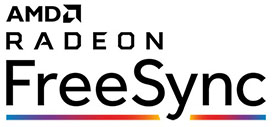
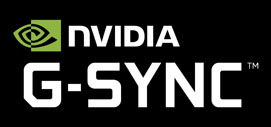
|
AMD FreeSync support |
|
|
FreeSync certification level |
FreeSync Premium |
|
NVIDIA G-sync support |
|
|
G-sync certification level |
None |
The screen features adaptive sync support and so can offer variable refresh rates (VRR) capabilities from both AMD FreeSync and NVIDIA G-sync systems. It is certified under the new 'FreeSync Premium' scheme but not under the NVIDIA G-sync Compatible scheme. A VRR range of 48 - 144Hz is supported over DisplayPort, with Low Framerate Compensation (LFC) included. Note that adaptive-sync is not supported over HDMI on this screen.
The support for FreeSync and G-sync will be very useful given the significant system demands of running a screen at 3440 x 1440 resolution and up to 144Hz refresh rate. It was of course very good to see it included here. You might also want to read our newly updated article about Variable Refresh Rates here. Note that you can turn adaptive-sync on/off within the OSD menu. We noticed an odd bug with the screen if you turn adaptive-sync OFF and run at 144Hz. The text rendering is not as sharp, and it almost looks as if you've changed your colour output to use chroma sub-sampling, it's a very similar effect. This only happens at 144Hz with adaptive-sync turned off in the OSD. All lower refresh rates are fine. If you turn adaptive-sync on (and you can always then turn FreeSync/G-sync off in your graphics card control panel if you want), then there's no issue. We can't see any reason why you'd really ever want to turn adaptive-sync off in the OSD anyway but we mention it for completeness since we had spotted it during our testing.

Detailed Response Times
The response time performance of the EDG34S was thankfully simple, as you could comfortably stick with the 'Middle' Response Time mode we felt for all refresh rates, including for VRR and for a fixed 60Hz input sources. The higher refresh rates really help improve motion clarity and reduce perceived blur, making the screen far better for gaming than 60Hz-only models. The support for VRR from both AMD and NVIDIA systems was welcome as ever, particularly useful given the high demands of this resolution and refresh rate combination.
Recommended Settings
|
Optimal Refresh Rate |
144Hz |
|
Optimal Overdrive Setting (for above) |
Middle |
|
Optimal Overdrive Setting for 60Hz |
Middle |
|
Optimal Overdrive Setting for VRR |
Middle |
Detailed Measurements at optimal
144Hz, Response Time = Middle
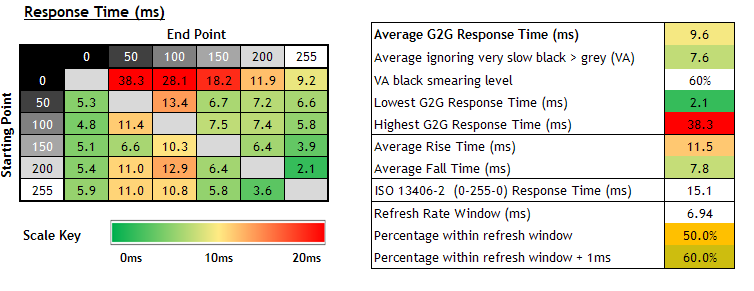
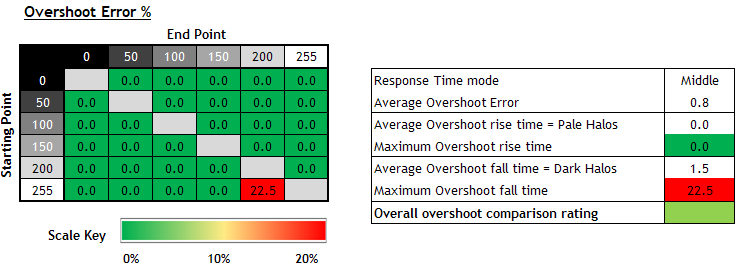
We carried out some further response time measurements at 144Hz and at the optimal 'Middle' response time setting. The average response time was measured at 9.6ms G2G. Along the top row of the table you can see the typical problematic black > grey transitions which are slow on nearly every VA technology panel. This causes some added black smearing on moving content in practice and we would rate the black smearing level at 60% here. If we were to ignore those problematic slow transitions the average response time would be 7.6ms G2G which is pretty decent. There was basically no overshoot at all, except on one transition from white to light grey where a bit appeared. Overall though in this Middle mode you won't notice any issues with overshoot halos or artefacts. At 144Hz you ideally need response times to be consistently under 6.94ms, or close to that. Only 50% of the measured transitions were within this "refresh rate window" and so you get a little bit of added blurring as a result, compared to if they were keeping up a bit better. Overall though the motion clarity was pretty decent thanks to the high refresh rate, and pretty aligned to many other modern VA panels to be honest.

Gaming Comparisons
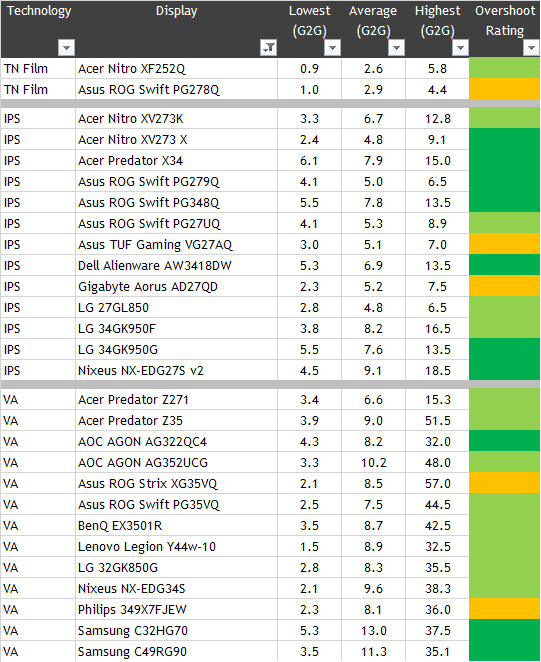
We have provided a comparison of the display against many other gaming screens we have reviewed in a similar size range and across a range of panel technologies. This table is now split by panel technology to make life a bit easier and for quicker comparison. We've used the results from the FreeSync ON tests here since that is the optimal setting for this screen for PC gaming.
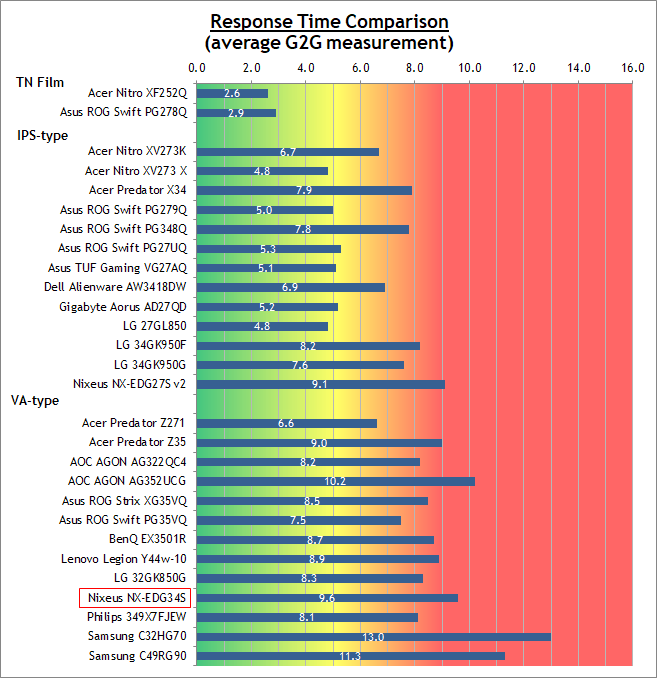
Overall the response times of the EDG34S were a bit slower than some of the other high refresh rate VA panels we've tested, with some moderate (60%) levels of black smearing which we will compare a little more in a moment. There was at least very little overshoot which was very pleasing, and the 144Hz refresh rate brought about noticeable improvements in motion clarity compared with 60Hz. We would have liked to have seen the overdrive applied a bit more aggressively really to boost the response times further, even if some minor levels of overshoot started to appear.
VA Technology Display Comparison
To try and give a more direct comparison between the different VA models we've tested we have produced the following new comparison table below. Each screen is set to the optimal response time setting and refresh rate from our reviews.
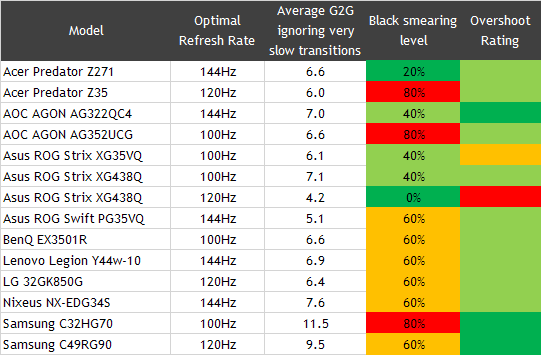
You can see that the EDG34S is fairly typical
in its level of black smearing at 60%, sitting somewhere in the middle of the VA
models we've tested to date. Thankfully it has no overshoot
which is good news.
![]()
To explain the "black smearing" measurement above. The higher the black smearing level (as a %), the worse the screen is in this regard. The "Black smearing level" is determined by looking at the response times along the top row of our measurements which are those changing from black (0) to various grey shades (50, 100 and 150 levels) and white (255). If we take the response time measurements from the display here at 144Hz there are 3 transitions which are particularly slow (anything above 15ms is considered too slow) and problematic so in this example 60% of the black transitions are slow here (3 out of 5). If a screen has 4 very slow transitions its black smearing level would be 80% and so on.

Lag
Read our detailed article about input lag and the various measurement techniques which are used to evaluate this aspect of a display. The screens tested are split into two measurements which are based on our overall display lag tests and half the average G2G response time, as measured by our oscilloscope. The response time element, part of the lag you can see, is split from the overall display lag and shown on the graph as the green bar. From there, the signal processing (red bar) can be provided as a good estimation of the lag you would feel from the display. We also classify each display as follows:
Lag Classification
-
Class 1) Less than 8.33ms - the equivalent to 1 frame lag of a display at 120Hz refresh rate - should be fine for gamers, even at high levels
-
Class 2) A lag of 8.33 - 16.66ms - the equivalent of one to two frames at a 120Hz refresh rate - moderate lag but should be fine for many gamers. Caution advised for serious gaming
-
Class 3) A lag of more than 16.66ms - the equivalent of more than 2 frames at a refresh rate of 120Hz - Some noticeable lag in daily usage, not suitable for high end gaming
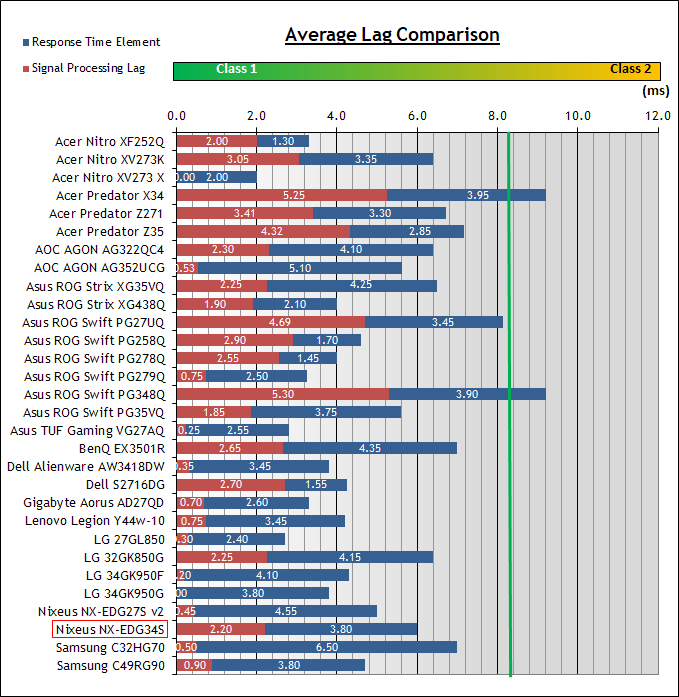
For the full reviews of the models compared here and the dates they were written (and when screens were approximately released to the market), please see our full reviews index.
|
|
We measured the same lag at all refresh rates on the EDG34S. There was a total display lag of 6ms, so with around 3.8ms of that accounted for by pixel response times we can estimate a signal processing lag of only 2.20ms. This is a very good result and makes the screen well suited to fast gaming.

Movies and Video
The following summarises the screens performance for videos and movie viewing:
|
Category |
Display Specs / Measurements |
Comments |
|
Size |
34" ultrawide |
Large for a desktop monitor currently |
|
Aspect Ratio |
21:9 |
A lot of content and devices might not be set up for this wide format, and so you may end up with black bars down the right and left hand sides, particularly for common 16:9 input sources |
|
Resolution |
3440 x 1440 |
Can support native 1080p content but not Ultra HD 4K natively |
|
HDCP |
Yes |
Suitable for encrypted content |
|
Connectivity |
2x DisplayPort 1.4 |
Useful additional 2x HDMI input for external Blu-ray players or games consoles |
|
Cables |
DisplayPort only |
Not provided with an HDMI cable in the box |
|
Ergonomics |
S model = Tilt only |
Very limited ergonomic adjustments from the S model, only a basic and limited tilt. Go for the fully adjustable stand version if you can |
|
Coating |
Light Anti-glare |
Provides clear, non-grainy image and avoids unwanted reflections of full glossy solutions |
|
Brightness range |
62 - 402 cd/m2 |
Good adjustment range offered including a fairly high peak brightness. Flicker free backlight operation with no PWM |
|
Contrast |
3005:1 after calibration |
Very good VA contrast ratio which should still be great for dark content and offering good shadow detail. |
|
Preset modes |
Movie |
There is a 'Movie' preset mode which by default is at max brightness and cannot be changed. Colour temp comparable to our calibrated state but too bright really to make it viable to use |
|
Response times |
9.6ms G2G, no overshoot at 144Hz (Middle RT mode) 10.2ms G2G at 60Hz with no overshoot (Middle RT mode) |
Response times are reasonable but not great. There is at least next to no overshoot in the optimal 'Middle' response time mode. 60Hz is probably more applicable for this section, and overall the response times were adequate for external devices and Blu-ray players. Some typical VA black smearing on moving content is visible. |
|
Viewing angles |
Good |
Not as wide as IPS, and fairly typical for a VA panel. Free from the pale "IPS-glow" on dark content when viewed from an angle that you see on IPS panels but do suffer from the black crush when viewed head on. May lose some detail in darker scenes as a result |
|
Backlight bleed |
No major bleed |
Some slight leakage along top and bottom but hard to see during normal use |
|
Audio |
Headphone output |
No integrated speakers on this model but a headphone jack is provided |
|
Aspect Ratio Controls |
Widescreen, 4:3, 1:1 and auto modes |
Good options to account for non-21:9 format inputs via the "auto" and "1:1" modes if needed. Useful given a lot of inputs are 16:9 format. Note that these modes are not selectable if adaptive-sync is turned on in the OSD |
|
PiP / PbP |
Not available |
Neither supported on this model |
|
HDR |
Nothing meaningful |
The screen can accept an
HDR input signal but lacks any form of backlight local dimming to actually
improve the dynamic range in practice. |

Conclusion
If you enjoy our work and want to say thanks, donations to the site are very welcome. If you would like to get early access to future reviews please consider becoming a TFT Central supporter.
The EDG34S is aimed primarily at gaming so let's focus on those uses to start. This is one of the few currently available 34" ultrawide panels to offer a 3440 x 1440 resolution VA technology panel and 144Hz refresh rate. This separates it from the wide range of 100Hz options available in the market, bringing about some motion clarity benefits and support for higher frame rates. The ever-useful AMD FreeSync and NVIDIA G-sync support is welcome, helping to accommodate variable refresh rates and cope with the high system demands of running this resolution at this refresh rate. We were pleased with the low lag of the screen as well. There was unfortunately some pretty typical VA black smearing on moving content, where black>grey transitions were still quite problematic, but that's common with pretty much all VA panels. You know what you're getting really with a VA panel, and this is offset somewhat by the very strong contrast ratio and general good all round performance. We were also pleasantly surprised by the wider-than-expected color gamut which gives a nice boost in vividness for gaming and multimedia.
For other uses the default setup was decent enough and the contrast ratio was high as we said before. The screen is missing an sRGB emulation mode which would have been useful for other colour critical work and things like that, but it's not really the target market of this screen to be honest. The stand on the S model is very limited so we would thoroughly recommend getting the normal version if you can with more versatile stand.
The EDG34S offers a
decent all round performance and impressive spec considering it's relatively low
retail price.
It is available in key regions from
Amazon where you can
check latest pricing (affiliate link). If you're a
fan of VA technology and don't really want all the bells and whistles that a lot
of more expensive models offer - you just want something solid for gaming - this
is a good option.
|
Pros |
Cons |
|
144Hz refresh rate currently rare in the 34" ultrawide VA market, offering improvements over common 100Hz |
Stand on the S model is very limited |
|
Low lag for gaming as well as FreeSync and G-sync VRR support |
Lacking an sRGB emulation mode |
|
Very strong contrast ratio and deep blacks |
Typical VA response times, so still some black smearing on moving content |
|
Check Pricing and Buy - Affiliate Links |
|
TFTCentral is a participant in the Amazon Services LLC Associates Programme, an affiliate advertising programme designed to provide a means for sites to earn advertising fees by advertising and linking to Amazon.com, Amazon.co.uk, Amazon.de, Amazon.ca and other Amazon stores worldwide. We also participate in a similar scheme for Overclockers.co.uk. |


